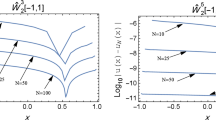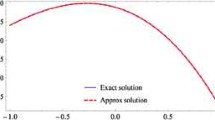Abstract
The High order Gradient Reproducing Kernel in conjunction with the Collocation Method (HGRKCM) is introduced for solutions of 2nd- and 4th-order PDEs. All the derivative approximations appearing in PDEs are constructed using the gradient reproducing kernels. Consequently, the computational cost for construction of derivative approximations reduces tremendously, basis functions for derivative approximations are smooth, and the accumulated error arising from calculating derivative approximations are controlled in comparison to the direct derivative counterparts. Furthermore, it is theoretically estimated and numerically tested that the same number of collocation points as the source points can be used to obtain the optimal solution in the HGRKCM. Overall, the HGRKCM is roughly 10–25 times faster than the conventional reproducing kernel collocation method. The convergence of the present method is estimated using the least squares functional equivalence. Numerical results are verified and compared with other strong-form-based and Galerkin-based methods.
























Similar content being viewed by others
References
Nayroles B, Touzot G, Villon P (1992) Generalizing the finite element method: diffuse approximation and diffuse elements. Comput Mech 10(5):307–318
Belytschko T, Krongauz Y, Organ D, Fleming M, Krysl P (1996) Meshless methods: an overview and recent developments. Comput Methods Appl Mech Eng 139(1–4):3–47
Belytschko T, Lu YY, Gu L (1994) Element-free Galerkin methods. Int J Numer Methods Eng 37(2):229–256
Lancaster P, Salkauskas K (1981) Surfaces generated by moving least squares methods. Math Comput 37(155):141–158
Chen J-S, Pan C, Wu C-T, Liu WK (1996) Reproducing kernel particle methods for large deformation analysis of non-linear structures. Comput Methods Appl Mech Eng 139(1–4):195–227
Liu WK, Jun S, Zhang YF (1995) Reproducing kernel particle methods. Int J Numer Methods Fluids 20(8–9):1081–1106
Liu W-K, Li S, Belytschko T (1997) Moving least-square reproducing kernel methods (i) methodology and convergence. Comput Methods Appl Mech Eng 143(1–2):113–154
Babuska I, Melenk JM (1995) The partition of unity finite element method. tech. rep., DTIC Document
Sukumar N (1998) The natural element method in solid mechanics. Ph.D. thesis, Northwestern University
Atluri S, Cho J, Kim H-G (1999) Analysis of thin beams, using the meshless local Petrov–Galerkin method, with generalized moving least squares interpolations. Comput Mech 24(5):334–347
Strouboulis T, Babuška I, Copps K (2000) The design and analysis of the generalized finite element method. Comput Methods Appl Mech Eng 181(1):43–69
Liu WK, Han W, Lu H, Li S, Cao J (2004) Reproducing kernel element method. Part I: theoretical formulation. Comput Methods Appl Mech Eng 193(12):933–951
Chen J-S, Wang H-P (2000) New boundary condition treatments in meshfree computation of contact problems. Comput Methods Appl Mech Eng 187(3–4):441–468
Fernández-Méndez S, Huerta A (2004) Imposing essential boundary conditions in mesh-free methods. Comput Methods Appl Mech Eng 193(12–14):1257–1275
Moës N, Bechet E, Tourbier M (2005) Imposing essential boundary conditions in the extended finite element method, In: VIII international conference on computational plasticity. Citeseer, Barcelona
Fonseca A, Viana S, Silva E, Mesquita R (2008) Imposing boundary conditions in the meshless local Petrov–Galerkin method. IET Sci Meas Technol 2(6):387–394
Boyce B, Kramer S, Bosiljevac T, Corona E, Moore J, Elkhodary K, Simha C, Williams B, Cerrone A, Nonn A et al (2016) The second sandia fracture challenge: predictions of ductile failure under quasi-static and moderate-rate dynamic loading. Int J Fract 198(1–2):5–100
Liu G-R, Zhang G, Gu Y, Wang Y (2005) A meshfree radial point interpolation method (RPIM) for three-dimensional solids. Comput Mech 36(6):421–430
Hu H-Y, Li Z-C (2006) Collocation methods for Poisson’s equation. Comput Methods Appl Mech Eng 195(33):4139–4160
Li Z-C, Lu T-T, Hu H-Y, Cheng AH (2008) Trefftz and collocation methods. WIT Press, Ashurst
Hardy RL (1971) Multiquadric equations of topography and other irregular surfaces. J Geophys Res 76(8):1905–1915
Hardy RL (1990) Theory and applications of the multiquadric-biharmonic method 20 years of discovery 1968–1988. Comput Math Appl 19(8–9):163–208
Kansa EJ (1990) Multiquadrics—a scattered data approximation scheme with applications to computational fluid-dynamics—II solutions to parabolic, hyperbolic and elliptic partial differential equations. Comput Math Appl 19(8):147–161
Hon Y, Schaback R (2001) On unsymmetric collocation by radial basis functions. Appl Math Comput 119(2):177–186
Kansa E, Hon Y (2000) Circumventing the ill-conditioning problem with multiquadric radial basis functions: applications to elliptic partial differential equations. Comput Math Appl 39(7–8):123–137
Aluru N (2000) A point collocation method based on reproducing kernel approximations. Int J Numer Methods Eng 47(6):1083–1121
Kim DW, Kim Y (2003) Point collocation methods using the fast moving least-square reproducing kernel approximation. Int J Numer Methods Eng 56(10):1445–1464
Onate E, Idelsohn S, Zienkiewicz O, Taylor R (1996) A finite point method in computational mechanics. Applications to convective transport and fluid flow. Int J Numer Methods Eng 39(22):3839–3866
Hu H-Y, Chen J-S, Hu W (2011) Error analysis of collocation method based on reproducing kernel approximation. Numer Methods Partial Differ Equ 27(3):554–580
Hu H-Y, Lai C-K, Chen J-S (2009) A study on convergence and complexity of reproducing kernel collocation method. National Science Council Tunghai University Endowment Fund for Academic Advancement Mathematics Research Promotion Center, Taichung City
Hu H, Chen J, Hu W (2007) Weighted radial basis collocation method for boundary value problems. Int J Numer Methods Eng 69(13):2736–2757
Wang D, Wang J, Wu J (2018) Superconvergent gradient smoothing meshfree collocation method. Comput Methods Appl Mech Eng 340:728–766
Chi S-W, Chen J-S, Hu H-Y, Yang JP (2013) A gradient reproducing kernel collocation method for boundary value problems. Int J Numer Methods Eng 93(13):1381–1402
Li S, Liu WK (1999) Reproducing kernel hierarchical partition of unity, part I—formulation and theory. Int J Numer Methods Eng 45(3):251–288
Li S, Liu WK (1999) Reproducing kernel hierarchical partition of unity, part II—applications. Int J Numer Methods Eng 45(3):289–317
Chen J-S, Zhang X, Belytschko T (2004) An implicit gradient model by a reproducing kernel strain regularization in strain localization problems. Comput Methods Appl Mech Eng 193(27):2827–2844
Li S, Liu WK (1998) Synchronized reproducing kernel interpolant via multiple wavelet expansion. Comput Mech 21(1):28–47
Chen J-S, Wu C-T, Yoon S, You Y (2001) A stabilized conforming nodal integration for Galerkin mesh-free methods. Int J Numer Methods Eng 50(2):435–466
Chen J-S, Hillman M, Chi S-W (2017) Meshfree methods: progress made after 20 years. J Eng Mech 143(4):04017001
Han W, Meng X (2001) Error analysis of the reproducing kernel particle method. Comput Methods Appl Mech Eng 190(46–47):6157–6181
Mirzaei D, Schaback R, Dehghan M (2012) On generalized moving least squares and diffuse derivatives. IMA J Numer Anal 32(3):983–1000
Timoshenko SP, Woinowsky-Krieger S (1959) Theory of plates and shells. McGraw-hill, New York
Auricchio F, Da Veiga LB, Hughes T, Reali A, Sangalli G (2010) Isogeometric collocation methods. Math Models Methods Appl Sci 20(11):2075–2107
Reali A, Gomez H (2015) An isogeometric collocation approach for Bernoulli–Euler beams and Kirchhoff plates. Comput Methods Appl Mech Eng 284:623–636 (Isogeometric Analysis Special Issue)
Qi D, Wang D, Deng L, Xu X, Wu C-T (2019) Reproducing kernel mesh-free collocation analysis of structural vibrations. Eng Comput 36(3):734–764
Guan P, Chi S, Chen J, Slawson T, Roth M (2011) Semi-Lagrangian reproducing kernel particle method for fragment-impact problems. Int J Impact Eng 38(12):1033–1047
Siriaksorn T, Chi S-W, Foster C, Mahdavi A (2018) u-p semi-Lagrangian reproducing kernel formulation for landslide modeling. Int J Numer Anal Methods Geomech 42(2):231–255
Acknowledgements
Research reported in this paper was partially supported by DoD SERDP under contract number W912HQ18C0099.
Author information
Authors and Affiliations
Corresponding author
Additional information
Publisher's Note
Springer Nature remains neutral with regard to jurisdictional claims in published maps and institutional affiliations.
Appendices
Appendix A
To demonstrate how exactly the procedure shown in Sect. 2.4 works for constructing gradient reproducing kernel shape function’s derivative of a desired order, second derivative approximation of the two-dimensional vector field \(\varvec{u}\) is considered:
where \(\varvec{w}_{xx}\), \(\varvec{w}_{xx}\), and \(\varvec{w}_{xy}\) are the gradient second order derivatives approximation of vector field \(\varvec{u}\). Recalling (19),
where \(\varvec{C}^i\), \(i=1, 2, 3\), are the corresponding correction functions for each case constructed by the related coefficients vector and quadratic basis vector,
where \(\varvec{b}^i\) in each case is obtained by satisfying the partition of nullity and derivative reproducing conditions, in this case second order derivatives reproducing conditions.
For the second derivative with respect to x the reproducing condition are,
By multiplying (A.4a) by x and subtracting (A.4b):
Multiplying (A.4a) by y and subtracting (A.4c) results in:
For quadratic terms, By multiplying (A.4a) by \(x^2\), adding (A.4d), and then subtracting two times of (A.4f),
By following the same procedure and multiplying (A.4a) by \(y^2\) and adding (A.4e) and abstracting two time of (A.4f),
and finally, for the last term, by multiplying (A.4a) by xy, \(-y\) by (A.4b), \(-x\) by (A.4c), and summing up all these expressions with (A.4f),
Writing all Eqs. (A.5)–(A.9) and including the partition of nullity in (A.4a),
The right-hand side in (A.10) is the second-order explicit derivative of quadratic basis vector where \(\varvec{x}-\varvec{x}_I=0\). By taking the same steps for satisfying \(\Psi ^{yy}\) and \(\Psi ^{xy}\) all the second-order derivative reproducing conditions become,
By using the definitions of gradient derivatives of RK function in (A.2) and correction function in (A.3) and substituting those into Eq. (A.11),
where \(\varvec{M}\) is the moment matrix defined in (8). Eventually, by having coefficients vector in (A.12), the second-order gradient derivatives are derived as,
Obviously, equations in (A.13) are just different by their first terms, which indicates that the method is straightforward and computationally efficient. More importantly, the inversion of moment matrix derivatives, which suffer from ill-conditioning and large condition numbers are no longer needed to be calculated. Following the same rule, higher order gradient derivatives could be obtained.
Appendix B
Sub-matrices shown in Eq. (54) are shown in the following. \(\varvec{A}^i\) (\(i=1,\ldots ,13\)) in the case of 4th-order Kirchhoff plate discrete equation is defined as,
and for sub-matrices \(\varvec{b}^i\) (\(i=1,\ldots ,5\)),
where \(N_d\) denotes the domain collocation points. \(N_g\), \(N_h\), \(N_m\), and \(N_q\) are the numbers of displacement, rotation, moment and shear boundary collocation points, respectively.
Rights and permissions
About this article
Cite this article
Mahdavi, A., Chi, SW. & Zhu, H. A gradient reproducing kernel collocation method for high order differential equations. Comput Mech 64, 1421–1454 (2019). https://doi.org/10.1007/s00466-019-01724-0
Received:
Accepted:
Published:
Issue Date:
DOI: https://doi.org/10.1007/s00466-019-01724-0




